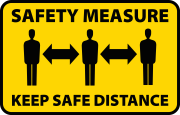A recent online poll held by GHD revealed that 70% of respondents do not feel comfortable returning to work unless social distancing measures are in place. The survey also showed that 60% of participants would like to see more permanent social distancing measures implemented at their workplace following the crisis.
The challenge
These results are an indication of the scale of the challenge facing businesses across the UK. Social distancing goes against the long-held ethos of maximising productivity and will require most businesses to operate inefficiently just when they need to be as efficient and safe as possible in order to recover from the economic impacts of lockdown.
The guidelines released by the UK government are a step forward in helping workplaces to understand some of the changes required to enable safe working during the COVID-19 pandemic. However, they are not specific enough to implement by themselves. They do not tell owners/operators how to determine the capacity, or how to ensure social distancing by reconfiguring spaces and designing new procedures that, importantly, account for the way people behave. More details on design and operations principles and standards are urgently needed nationally.
The solution
GHD subsidiary Movement Strategies applies people movement principles and simulations to provide organisations with the practical design and operations advice they need to reduce the likelihood of COVID-19 transmission in the workplace while also maximising capacity, complying with government guidance and demonstrating their commitment to health & safety to staff and stakeholders.
Using this technology and behavioural science backed approach, Movement Strategies has recently proven a doubling of space occupancy in a number of socially-distanced office environments while meeting health & safety and workplace regulations, thereby balancing the need for social distancing compliance and optimal productivity.
Simon Ancliffe, Executive Director at Movement Strategies, said: “The well-being of people is critical to economic recovery. There is a real need to build confidence in the creation of safe working environments, while simultaneously optimising the productivity of space. As people are encouraged to get back to work, businesses will need to move quickly to develop detailed plans that will deliver optimal efficiency and safety, while responding to the way people behave and use space.
We have been working with a wide range of sectors, including healthcare, retail, construction and manufacturing, and are seeing the same challenges arise across the board. We strongly advise organisations to remember that “2 metres” is not as straightforward as it seems and social distancing should be considered “dynamically” not “statically”. In addition, human behaviours must be considered when implementing solutions. It is extremely important that social distancing procedures are monitored and measured as they are adopted into daily operations, as this will be vital in helping to create better and safer ways of working in the future.”



